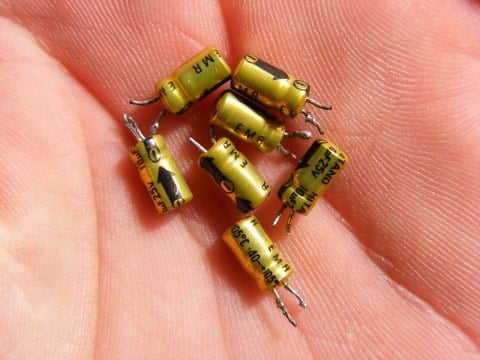This article will explore a brief history of supercapacitors, their construction, operation, and some modern applications.
Brief History of Supercapacitors
Since the 1950s, General Electric engineers were already experimenting with various designs of supercapacitors using carbon electrodes (although they were nevertheless not immediately commercialised).
They discovered that such a spongy material was capable of storing huge amounts of charge due to its large specific surface area. Later on, researchers at Standard Oil of Ohio (SOHIO) developed the double-layer capacitor while experimenting with fuel cell designs.
This early model utilised aluminium and activated carbon electrodes, which were separated by a thin dielectric material and liquid electrolyte. In 1971, NEC Corporation, Japan acquired a licence for the technology from SOHIO and marketed the products as ‘supercapacitors’. Ever since then, major manufacturers (such as Maxwell, LS Mtron, and Panasonic) have been mass-producing the components in their factories.
What are Supercapacitors?
Supercapacitors (aka ultracapacitors) are passive components that store energy via electrostatics. They differ from standard capacitors in that they have significantly higher capacitances. Moreover, supercapacitors are ideal for applications that require high-density power or rapid charge/discharge (intermittent) cycles.
For example, ceramic capacitors have capacitances in the pF (picofarad) to μF (microfarad) ranges, while supercapacitors (such as Eaton’s XT large-cell supercapacitors) have capacitances ranging from 275F to 555F.

Supercapacitors being held in the palm of a hand. Image Credit: Emilian Robert Vicol via Flickr.
How Do Supercapacitors Work?
There are three main types of supercapacitors, based on how they store electric charge:
The next three sections cover each of the above bullet-points.
Electric Double-Layer Capacitors
EDLC construction is the predominant technology used to design most supercapacitors. EDLCs comprise two conductive plates (electrodes) separated by a thin insulating layer (made of paper, carbon, or plastic) that are impregnated with an organic electrolyte.
The capacity of such a supercapacitor rises as the surface area of the electrodes increases and the barrier between the plates decreases. When an EDLC is connected to a power source, positive and negative ions within the insulating layer migrate into electrodes of reverse polarity. Such a dual-layer separation of charges, which is caused by an electric field set up between the plates and applied voltage, is known as a Helmholtz double layer.

A schematic of an electric double-layer supercapacitor. Image Credit: Stanford.edu.
Pseudocapacitors
Also known as redox capacitors, pseudocapacitors fall into one of two types (based on the nature of their electrodes): one type uses metal oxide electrodes, such as ruthenium oxide or manganese oxide; the second type uses conductive polymer electrodes, such as polyaniline or Polypyrrole.
Hybrid Supercapacitors
The hybrid supercapacitor construction consists of two electrodes with dissimilar characteristics: a positive EDLC-type electrode and a negative lithium-ion electrode. Both electrodes are usually impregnated with graphene (namely a thin layer of graphite).
Hybrid supercapacitors combine the benefits of electrostatic and electrochemical materials to achieve higher energy storage than EDLCs.

A worthy opponent to traditional batteries? Pictured: an example of electric, double-layer supercapacitors (Eaton XT supercapacitors). Image Credit: Eaton.
Advantages Over Batteries
Supercapacitors offer the following benefits over primary batteries and accumulators:
They’re High in Power Density
Supercapacitors have low equivalent series resistance (ESR) that allows them to store large amounts of energy very quickly. Unlike batteries, supercapacitors can charge up fully within seconds and deliver short bursts of current. As a result, they can be used to augment existing battery storage to ensure maximum uptime of devices and equipment.
They’re Eco-friendly
As supercapacitors do not require electrolytes to store charges, they generally contain no toxic chemicals. Most products utilise eco-friendly materials for the dielectric and conducting plates.
They’re Lightweight and Compact
Supercapacitors provide portable energy storage devices that meet space constraints in component-dense applications. EDLC construction can be implemented in small-footprint devices without sacrificing the energy storage capacity.

Consider the small and efficient size and shape of supercapacitors. Pictured: a group of compact supercapacitors all sit in close proximity to each other on a desk. Image Credit: Windell Oskay via Flickr.
They’re Durable
Unlike lithium-ion batteries and accumulators, which are prone to leaks, overheating, and bloating (thus considerably lowering the maximum capacity of their relevant host device), supercapacitors have a wide range of operating temperatures, which ensures that their host devices, can be started up reliably, even in cold weather.
Longevity
Supercapacitors last significantly longer than batteries or accumulators. They achieve millions of charge/discharge cycles over several years with minimal degradation.

There’s no underestimating the power of supercapacitors. Pictured: a montage featuring a virtual reality headset and medtech robotic hand to reflect on the application potential of Vishay Intertechnology’s electrical double-layer energy storage capacitors. Image Credit: Vishay Intertechnology.
Applications of Supercapacitors
Supercapacitors are ideal for applications that require large amounts of power to be stored and released quickly. Just some of the applications are covered in the below sections.
Power Stabilisation
Supercapacitors can be utilised (again, in place of batteries) to stabilise power transmission by mitigating fluctuations in power quality, frequency, and voltage.
They provide cost-effective backup or ride-through power to utility/microgrids in times of peak demand (particularly for voltage balancing or frequency regulation) by both delivering high-density power and quickly storing any excess power to prevent wastage. Accordingly, common applications are in wind farms and solar power plants.
Automobiles
Supercapacitors enable regenerative braking (pictured above) in modern automobiles and commercial vehicles. In regenerative braking systems, supercapacitors briefly capture the excess energy produced by the motor when the vehicle is at rest and release it when it starts moving again.
Supercapacitors are also utilised in hybrid cars and trucks (i.e. vehicles that utilise a mixture of fossil fuels) to improve the efficiency of fuel cells.
Realising the Potential of Supercapacitors
Ultimately, although supercapacitors have been around for a long time, both electrical engineers and manufacturers are yet to fully harness their capabilities in modern devices and equipment. After all, supercapacitors are ideal for space-constrained applications that require high-density power—and they ultimately contribute significantly to lower toxic emissions to the environment after disposal.








